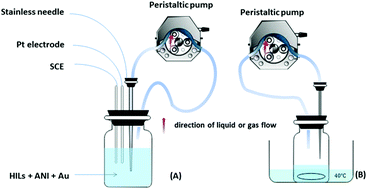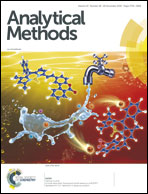A novel needle trap device coupled with gas chromatography for determination of five fatty alcohols in tea samples†
Abstract
A novel needle trap device (NTD) was presented, the inner wall of which was coated with polyaniline doped with proton-type ionic liquid and gold nanoparticles (PANI-HILs-Au). It was prepared by in situ electropolymerization in a stainless steel syringe, which was immersed in an electrolyte containing gold nanoparticles, aniline, and 1-sulfobutyl-3-methylimidazolium hydrogen sulfate ([BHSO3MIm] HSO4, C8H16N2O7S2), and the electrolyte was pumped continuously. The coating of PANI-HILs-Au was characterized by SEM, EDS and FT-IR. The surface of the coating presented granular porous structures, and the doping of gold nanoparticles resulted in fine and uniform morphology. When NTD was coupled with solid-phase microextraction (SPME) and gas chromatography (GC) for the detection of 1-octanol, 1-nonano, decyl alcohol, 1-undecanol and 1-dodecanol, good extraction efficiency was obtained. Under optimized conditions, the linear range (LR) was 0.73–500 μg L−1, and the limits of detection (LOD) were in the range of 0.09–0.18 μg L−1 (S/N = 3). The relative standard deviations (RSDs) of chromatography peak areas for different fatty alcohols were satisfactory. This method was successfully applied for the determination of fatty alcohols in tea samples, and the recoveries were in the range of 94.6–110.5%.



 Please wait while we load your content...
Please wait while we load your content...